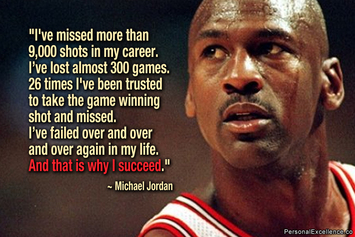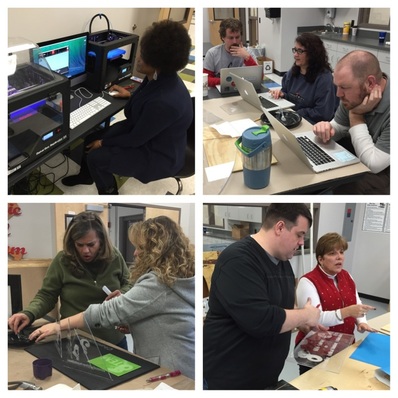 There has been a sweeping movement in education (especially math education) that has placed a high level of importance on students learning through failing. The general thought is that when a student tries to solve thought provoking, challenging problems, the instructor should cultivate an environment that embraces the power of learning new techniques by stretching slightly beyond the student's current abilities. While I completely agree with this philosophy, I have seen far too many instances where school leaders claim to support this research based strategy, but then put such a heavy hand on the faculty that they squelch their willingness to innovate because of risk of failure. Below are five facts that I believe are critical to successfully failing.
2 Comments
 STEM School teachers in a maker event in our Fab Lab. STEM School teachers in a maker event in our Fab Lab. As a Fabrication Laboratory (Fab Lab) instructor at STEM School Chattanooga, I recently had the opportunity to facilitate a day long "Maker PD" for our faculty. The goals for the activity were to: 1) give teachers a chance to developed relationships with others they do not ordinarily work with, 2) acquire a basic understanding of the types of products our students can produce in the Fab Lab, and 3) have teachers work through the process of producing a display-quality product in a short amount of time. The day started with a brief demonstration of our high-tech production equipment intended to give everyone a 'tip of the iceberg' glimpse of what could be accomplished in the lab. After the introduction, the teachers were placed into teams of three and given a sample of raw materials they could use to build their product. They were challenged to make a display piece that represented the school's mission. At the end of the day, no group had really finished the task. In fact, none of the teams had finished products, but all of the teams had amazing products in the works. We concluded the day long session with a debrief in which the teams discussed the ups and downs of the day, the inspiration for their designs, and the joys and frustrations they experienced throughout the challenging process. In reflection, I have summarized those observations into 5 keys to successful collaboration. 1. Heterogeneous groups allow teammates to fill each other's gaps. When teams are populated with diverse personalities and skill sets, the participants are able to work incredibly efficiently to accomplish the goal. If the participants are willing to accept roles and value the roles of others, they are empowered to piggy back off the strengths of their teammates to accommodate each other's shortcomings and produce a high quality product. This also magnifies the opportunity to legitimately share individual expertise and hone specific skills within a non-threatening context. Mature learners recognize and embrace these differences as strengthening agents. Young participants must be taught the value of diversity and the potential benefits of heterogeneous grouping. Facilitators must work to ensure that participants are able to value the strengths of their teammates while accepting the fact that they approach the task differently. 2. Homogenous groups experience less conflict but must persevere to overcome shortcomings. When teams are populated with similarly minded individuals, the collaborative process is naturally smooth, but the group must work to overcome their similar weaknesses without a teammate who can fill the gap. For example, a non-creative team must work to overcome this shortcoming if none of the participants poses the ability to provide this necessary skill. To do this successfully, homogeneous groups must work through initial frustration and persevere through their weaknesses. Mature learners do this instinctively but younger participants must be coaxed to avoid quitting due to initial frustration from perceived inability. 3. Acquiring competencies while trying to create a quality product eventually fosters a debilitating level of frustration. Facilitators must deliberately set explicit expectations that are appropriately aligned with participants' abilities. When individuals feel pressure to produce high-quality work before they have developed the appropriate skill sets, they are likely to experience a level of frustration that is unproductive and promotes apathy. Regardless of the maturity level of the learner, most individuals eventually cave to the frustration that can result from an unbalanced competency to expectation ratio. This can result from either unclear expectations, or expectations that are too far beyond the ability level of the participants 4. When faced with a legitimate time crunch, teams must choose to sacrifice quality or design specs. When collaborative groups are genuinely invested in a project, they must have a high level of time-management skills or they must be willing to accept the fact that they will have to sacrifice initial design specifications or the quality of the finished product. For mature groups, this is done instinctively as they self-monitor throughout the process. For young learners, the facilitator must work to ensure that the group makes a collective decision regarding this sacrifice. If not managed properly, individuals can feel dejected and undervalued if their teammates choose to scrap his/her contribution to the product without clear rationale. 5. When teams are collaborating at a high level, it doesn't always look like everyone is doing something...and that's ok. Assessing collaboration must be done holistically. It is not possible to accurately assess the collaborative process by simply looking at a team with a glance, seeing a participant idle, and making a snap judgement that he/she is not contributing. While it is certainly important to ensure teams do not allow one individual to do all of the work, it is equally important to display an understanding that successful teams' participants will contribute in a variety of ways that may not look as "busy" as others. As the great coach John Wooden said, "Never confuse activity with accomplishment." Sometimes, the least affective members of a collaborative group are the ones that appear to be doing the most work. It is vital that facilitators take intentional steps to evaluate the collaborative process as a whole and that the results are used to develop a true value of teamwork among the participants. Remember that in many industries, the management team may look the least busy (in terms of physical activity) but they are often responsible for the majority of the high level decisions that ultimately delineate between the success or failure of the company. |
Michael StoneClick here to read about the blog's author. My BooksKeynotesCleveland Rotary Club
Innovating Education Through Community Partners NEA Foundation The Promise of Public Ed Leveraging Teacher Leadership to Increase STEM Education US Senate Briefing The Need for a National Organizing Body of Digital Fabrication NACCE California Symposium Scaling Innovation through Partnerships Volkswagen eLab Ribbon Cutting Why Digital Fabrication can't be an Option NSTA STEM Leadership Developing, Incubating, and Implementing Public/Private Partnerships that Matter Chattanooga Fab Institute Revolutionizing Learning through Digital Fabrication HCDE Future Ready Institute Launch Developing PBL Units with Business Partners STEM Fellows Celebration Community Partnerships for Teacher Leadership TSIN Summit Scaling Innovation in Schools Remake Learning Days Dig Fab in the Community America Achieves Public/Private Partnerships Panel DigiFabCon Chicago Digital Fabrication in the Modern Classroom Redesign for Student Success (San Diego) Scaling Innovation through Digital Fabrication GE Leadership Summit Leveraging Innovative Technologies for Learning Texas Open Innovation Emerging Innovations in Education Indiana University Authentic PBL FFT Leading & Learning Boston, MA Connecting Global Ed reMake Education Summit Keynote National Governor's Asc. Coding with Governors US Dept of Education Round Table with Secretary John King TSIN Summit K-12 Pathways for CS Google Headquarters Ed Foo NASA Headquarters K-12 Education Panel White House Reducing the Racial Gap in Computing Boston Museum of Science Teaching with Toys US Dept of Education MSP CS Proposition Archives
October 2018
|


